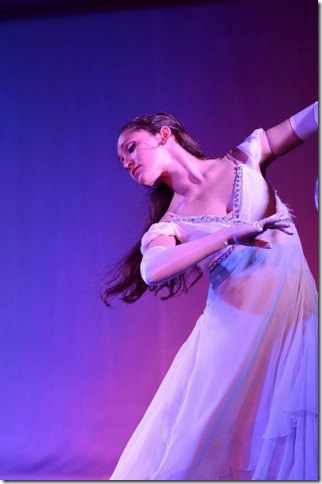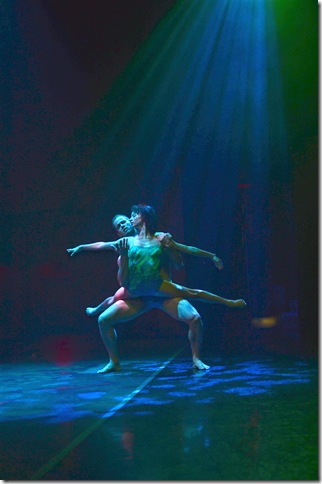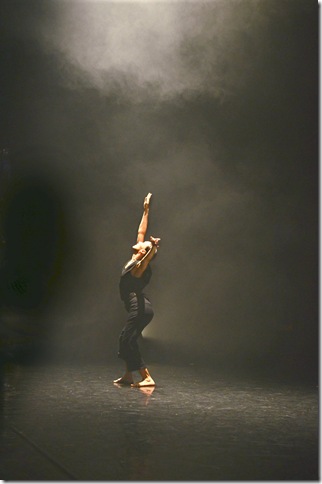It’s a pity that the annual dance intensive summer show produced by the Reach and O Dance companies only had one performance Saturday night, because this collection of modern, jazz and ballet moves showcased intriguing choreography and some standout individual dancers that more people should have been able to see.
The show, called Heat Wave, and which contained a touching tribute to two Dreyfoos School of the Arts teenagers slain in January, showcased the work of O Dance’s Jerry Opdenaker and Reach Dance’s Maria Konrad. Opdenaker, a former Ballet Florida standout, creates balletic works, and Konrad pursues modern dance; together, their collaborative show offers a pleasing variety of approaches.
Saturday night’s show at the Eissey Campus Theatre on the campus of Palm Beach State College in Palm Beach Gardens featured roughly 20 members of the intensive, a two-week course in dance styles that clearly gave all its participants plenty of interesting things to work on, and in. There were solo moments, but they were all by guest faculty or carefully integrated into the works: No divas or showboats in this highly democratic show.
Two short ballets by Opdenaker opened the show, Invenio, set to the hugely popular minimalist classic Spiegel im Spiegel, of the Estonian composer Arvo Pärt, and Lágrimas de la Madre, accompanied by the Spanish film composer Alberto Iglesias’s music for the Pedro Almodovar film Hable con Ella.
The Pärt work, which is most often heard in its violin-and-piano version, is an ideal soundtrack for water, with its glassy repetitiveness and air of eternal serenity. Opdenaker’s work featured two dancers, Sarah White and Eric Linder from the Florida Dance Theatre, and it took place along with a video of the ocean and a shoreline, which cut to the dancers as swimmers underneath the water. A simple sliding unit then opened up to reveal the actual dancers, who then came out to perform the bulk of the dance.
Invenio was a touching piece of ballet in which the two swimsuit-clad dancers explored and mimicked each other’s moves, suggesting a gently primal sort of human discovery, a physical poem for a subaqueous Adam and Eve. It was tender and loving without being highly charged, a set of classical poses danced by two very toned people who gave this gentle piece serious expression.
Lágrimas, which featured 14 females from the intensive clad in black dresses, operated with a good deal of motion above the music, as the dancers split off into smaller sections, came together, and performed a large repertory of hand motions evoking motherly duties, particularly rocking a baby, with the dresses of mourning suggesting loss and a disruption in the normal rhythm of life. Toward the end, the girls lifted their hands high above their heads and brought them down as they shifted to profile stances; the effect was a like a field of ebony wheat in the wind, bending and swaying, and I found it breathtakingly beautiful.
Two solo dances followed, beginning with student choreography winner Kristin Lee, dancing to a soul ballad by the British singer and producer Sampha Sisay. Lee’s Phasam was a somewhat restricted series of small moves in response to the song’s love-in-trouble lyrics; one wished for a bit more motion. Guest faculty member Ryan Redman, of the Trey McIntyre Project, appeared next, dancing to the Icelandic pop band Of Monsters and Men’s song “Steal Your Heart.” Redman, an impressively sculpted man, was shirtless and shoeless, dressed only in pants, and made the most of it. His work had the kind of powerful energy we associate with the McIntyre troupe, and in addition to his large repertory of hand and arm movements, he dashed off some exciting flips and rolls, in a way that was almost too forceful for the placidness of this particular song.
A five-part piece, Golden Age of Hollywood Suite, from Maria Konrad’s full-length ballet of that name, came next, performed by members of Reach Dance. The music included songs by Gershwin, Arlen and Bernstein, to classic recordings by Ella Fitzgerald and Judy Garland. The dances showed Konrad’s affinity for staging dance numbers in musicals; two of the songs, Arlen’s “Get Happy” and Gershwin’s “Fascinating Rhythm,” willingly explored those tropes, with the Bob Fosse-Judy Garland derby-and-jazz-hands approach for five dancers in “Get Happy,” and for “Fascinating Rhythm,” a dance that evoked the colors (black leotards and Technicolor skirts) and look of the Fred Astaire noir-detective ballet in the 1953 film The Band Wagon.
But these two dances were the least satisfying of the five, primarily because the dancers, who looked like they were having a good time, lacked drive and energy. Konrad choreographed many smart, funny moves and poses for them, and their ensemble was generally good, but the intensity level was at least a quart low.
Far better were the two solo dances, Kristen Patrick’s lovely ballroom-dancer-without-a-partner reading of Gershwin’s “But Not for Me,” and Corey Heins’ explosive tribute to Bernstein’s “New York, New York,” from the sailors-on-leave musical On the Town. In his seaman whites he looked as though he’d walked right off the set of the film, and his joyful dance won shouts from the sizable audience, particularly after a wonderful shoulder roll feint. Patrick also returned for Gershwin’s “The Man I Love,” in a pretty solo of romantic desperation that turned into a sensuous pas de deux with Juilliard student Jeremy Coachman.
The energy missing in part of Golden Age of Hollywood was found in the second half of the program, which opened with another Konrad work, Italia, a four-part jazz ballet with members of the intensive. The full version of this piece is set for performances Feb. 13-15, and it will be worth seeing. To music by Claudio Villa, the German band Club des Belugas, Sophia Loren (one of the film siren’s 1950s novelty recordings) and Rosario Fiorello, the moved across the stage in a variety of jumpy ensembles, and in the Loren piece they mouthed along with the nonsense refrain, adding to the fun. But the most exciting parts of the ballet were the large ensembles, with all the dancers running through a breathless vocabulary of high-octane leg and arm movements.
Another guest faculty member, Melissa Rector, was up next with a solo dance choreographed by Ronen Koresh, founder of the Philadelphia-based Koresh Dance Company for whom Rector works. An excerpt from Evolution, set to a percussion piece by Greg Smith, was an outstanding example of contemporary dance. Rector, dancing in black under a spotlight, moved with the snaps and pulse of the music, particularly a huge offbeat timpani stroke from which she recoiled. Her leg stretches and arm movements were exaggerated and dramatic, as though she was at the mercy of a godlike force that she had to react to but couldn’t comprehend. For her curtain call, she graciously applauded the members of the audience, reaching out to the dance students who were out in force.
Just an Idea for Something, last year’s winner in the intensive’s Launch choreography competition, was designed by Jazmine Colon and Emily Schwartz, and featured 15 dancers in black and white in a busy and attractive collection of ballet moves that read almost like exercises. It came off like a cousin to Opdenaker’s Lágrimas, and like that ballet had a kind of Agnes de Mille feel. Icelandic composer Olafur Arnalds’s music, a string quartet, accompanied the first part, but the second was a recording of a guitar piece by 16-year-old Alex Berman of Jupiter, a Dreyfoos student who died in January along with his sister Jackie, apparently at the hands of their mother, who then killed herself.
The dance, which was either added or existed to different music last year, ended with several rows of the dancers reaching out and moving forward in place with Alex Berman’s attractive, folky music behind it. It was hard not to be moved, especially because the dance itself was so positive and optimistic.
The evening closed with another piece by Konrad featuring her Reach company. Tradimento, which is Italian for treason or treachery, offered as its centerpiece a dynamic solo by Tara Langdon that ended with her pointing an accusatory arm at her fellow dancers as she spun slowly in a circle and her colleagues closed in. The final movement of the three-part dance, set to a hypnotic piece by the Welsh DJ known as Sasha (aka Alexander Coe), brought Konrad’s best dancers to the fore in an accretive manner, starting with Coachman by himself, and ending in a powerful pileup.
This was in general a very impressive evening of dance, well-presented and thought out. Kudos, too, to lighting designer Chris Esterline, who provided a beautiful effect in Italia with a distant star-like beacon on a blue background, and whose lighting overall supported the dance and set each of the moods expertly. Some of these pieces will return to the stage this coming season, and if you want to see some creative, interesting new dance in South Florida, the Reach Dance Company is a good place to see it.


